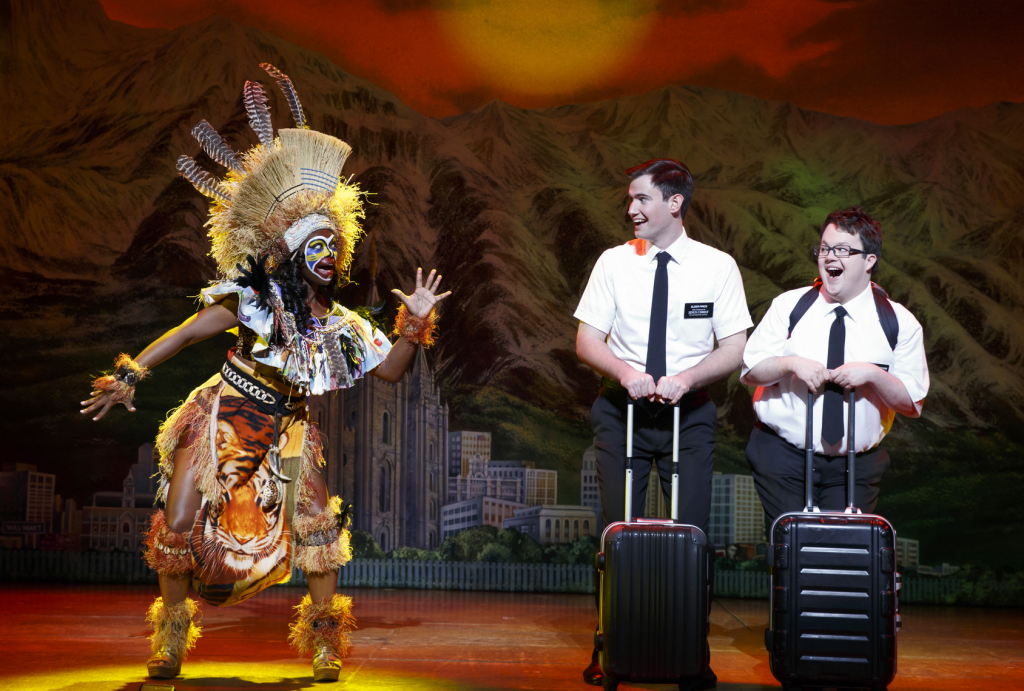Originally published in the April 2016 issue of (614) Magazine

How does a nice Catholic schoolboy from Canada become a Mormon missionary in Broadway’s longest running “knock-knock” joke?
Ask Ryan Bondy, the former understudy now starring as Elder Price in The Book of Mormon, returning to Columbus this month at the Ohio Theater.
Understudies are the second-string quarterbacks of the theater. They put in all of the same hours and sweat as the stars they shadow, but they only get to play when illness or injury suddenly push them from the sidelines into the spotlight.
When an understudy tells you to “break a leg,” he might just mean it.
“If Mormons had a poster boy for their religion, it is Elder Price,” Bondy explained. “Then he has a bit of a rude awakening. He presumes he’ll be sent on the mission he thinks he deserves, which in the play is Orlando. But instead, he’s sent to Uganda.”
That strained plot probably sounds like the worst idea for a Broadway play imaginable — maybe even worse than the hip-hop biography of Alexander Hamilton.
You’d be wrong on both counts. (The worst idea is still singing cats.)
In case you’ve been away on your own overseas mission, The Book of Mormon is the creation of Trey Parker and Matt Stone, the same evil geniuses behind South Park. If a Fight Club-style faceoff between Jesus and Santa Claus or Satan spooning Saddam Hussein wasn’t your idea of enlightenment, put down your protest signs right now. The Book of Mormon isn’t that kind of religious experience. But the soundtrack isn’t exactly the Osmond Family Christmas either.
“When my family learned I was going to be part of the show, there was a little bit of concern,” Bondy confessed. “Growing up Catholic, I understood what it meant to be devout to a faith. Every religion may have its absurdities, but this story itself isn’t meant to offend. It’s really about learning to love your neighbor—with some potentially offensive lyrics.”
Bondy’s own mission of sorts has taken him from his familiar upbringing in Ontario to a strange land south of the border, patiently waiting for that big break—leg or otherwise.
“Obviously being a stand-by, you have to be ready at a moment’s notice. That’s part of the stress—you don’t get to go on every night, but when you do, you kind of have to carry the show. That’s the intensity of the mid-show swing,” he explained. “You may hear or see something earlier in the show and you know you need to start warming up.”
That’s exactly what happened several times on the road, when a pulled muscle or failing voice of the show’s lead was Bondy’s cue to tighten that tie and find religion fast. (Never mind that he was stepping in for someone who was blonde, and significantly shorter.)
“You worry about taking the audience out of the show. But once there’s that forgiveness of a different person taking over, you know they’re back on your side,” he said. “There was a little ad-lib at the top of the second act to acknowledge that. Elder Cunningham simply says, ‘Elder Price, you look different?’ Then, the audience erupts and we all move forward.”
“I’ve been with the show for almost two and a half years, and I’ve been with all three companies—the two touring companies and Broadway. I’ve seen different portrayals of Elder Price and each actor brings a different authenticity to the role,” Bondy explained. “As an understudy, you trail those performances and try to maintain the integrity of the show.”
“Now that I’ve been given the chance to do the show nightly, one of the biggest things you realize is when you only do the show every two months, you’re really stepping into someone else’s shoes and someone else’s show,” he said. “When you become the lead, the cast starts to become familiar with your cadence and your humor. They feed you, you feed them, and there’s a bounce back and forth on stage that you never really get to experience as an understudy.”
“Being Canadian, I really didn’t understand how much U.S. audiences change, even in just a four-hour drive. Some places, like Florida, that have an older audience, there may still be that shock value. By the time we get to the second act, we’ve warmed them up,” Bondy explained. “I’ve also performed to some of our loudest audiences in the ‘Bible Belt’. But there are also places with protestors who only know it’s ‘those guys from South Park’, or have only listened to the soundtrack and taken the show out of context without even seeing it.”
“There are also cities with a strong Mormon presence where they come out to support the show. A big part of their faith is just to start a conversation. There isn’t a quota,” Bondy said. “They actually take advertisements out in our programs, ‘You’ve seen the play. Now read the book.’ They’ll often wait outside after our show to talk about their faith and answer questions.”
Among the most unexpected audience endorsements Bondy revealed was from a conversation he had with one such missionary following a recent show.
“It kind of threw me because he hadn’t even see the show that night. ‘Entertainment’ is prohibited during their missions,” he said. “But he told me he’d seen the play three years earlier, and it made him curious about the religion—enough so that he eventually ended up becoming a Mormon and is now bringing that faith to others.”
How’s that for a religious experience? ▩
The Book of Mormon runs at the Ohio Theatre from April 19-26. Tickets are on sale now through the CAPA ticket office and Ticketmaster. For more, visit capa.com.